This article was co-authored by Grace Imson, MA. Grace Imson is a math teacher with over 40 years of teaching experience. Grace is currently a math instructor at the City College of San Francisco and was previously in the Math Department at Saint Louis University. She has taught math at the elementary, middle, high school, and college levels. She has an MA in Education, specializing in Administration and Supervision from Saint Louis University.
There are 10 references cited in this article, which can be found at the bottom of the page.
This article has been viewed 890,999 times.
A liter (or litre) is a metric unit used to measure volume or capacity.[1] Liters are a common measurement often used to measure beverages and other liquids, such as a 2 liter bottle of soda. Sometimes you will need to calculate the volume of an object in liters, given the object's dimensions. In other instances, you will need to convert the volume of something that is already given in another unit, such as milliliters or gallons. In all of these instances, through simple multiplication or division, you can easily determine volume in liters.
Steps
Finding Volume in Liters from Dimensions
-
1Convert the dimensions to centimeters. If the dimensions are given in meters, inches, feet, or some other unit of measurement,convert each dimension to centimeters (cm) before calculating the volume.This will make it easier to convert to liters.
- Always double-check that the dimensions of the shape you're working with have the same unit before you calculate the volume.[2]
Key Conversions
1 meter = 100 centimeters.[3] So, if the length of a cube is 2.5 meters, that converts to 250 centimeters, since .
1 inch = 2.54 centimeters.[4] So, if the length of a cube is 5 inches, that converts to 12.7 centimeters, since .
1 foot = 30.48 centimeters.[5] So, if the length of a cube is 3 feet, that converts to 91.44 centimeters, since . -
2Find the volume of the shape. How you find the volume will depend on the shape of the three-dimensional object you are measuring, since the volume of each type of shape is calculated differently. To find the volume of a cube, you can use the formula.[6] The volume of a three-dimensional shape will be in cubic units, such as cubic centimeters ().
- For instance, if a fish tank is 40.64 cm long, 25.4 cm wide, and 20.32 tall you would calculate the volume by multiplying these dimensions together:
- To find the volume of a cylinder, start by finding the height of the cylinder. Then, find the radius of the circle at the top or bottom. Next, find the area of the circle, which you can find with the formula π, where r is the radius. Finally, multiply the area of the circle by the height of the cylinder to find the volume.[7]
Advertisement - For instance, if a fish tank is 40.64 cm long, 25.4 cm wide, and 20.32 tall you would calculate the volume by multiplying these dimensions together:
-
3Convert cubic centimeters to liters. To do this, use the conversion rate.Dividing the volume (in cubic centimeters) of the shape by 1,000 will give you the volume in liters (L).[8]
- If the volume of the fish tank, in cubic centimeters, is 20,975, to find the volume in liters, calculate . So, a fish tank that is 40.64 cm long, 25.4 cm wide, and 20.32 tall has a volume of 20.975 L.
Converting Liters from other Metric Units
-
1Convert milliliters to liters. There are1,000 milliliters (mL) in 1 liter (L).So, to convert milliliters to liters, you would divide the number of milliliters by 1,000.[9]
- If the volume of a carton of almond milk is 1,890 mL, to convert to liters, you would calculate .
-
2Convert centiliters to liters. There are100 centiliters (cL) in 1 liter.So, to convert centiliters to liters, you would divide the number of centiliters by 100.[10]
- If a the volume of a carton of almond milk is 189 cL, to convert to liters, you would calculate .
-
3Convert deciliters to liters. There are10 deciliters (dL) in 1 liter.So, to convert deciliters to liters, you would divide the number of deciliters by 10.[11]
- If a the volume of a carton of almond milk is 18.9 dL, to convert to liters, you would calculate .
-
4Convert kiloliters to liters. There are1000 liters in 1 kiloliter (kl).So, to convert kiloliters to liters, you would multiply the number of kiloliters by 1,000.[12]
- If the volume of a kiddie pool is 240 kl, to convert to liters, you would calculate .
-
5Convert hectoliters to liters. There are100 liters in 1 hectoliter (hl).So, to convert hectoliters to liters, you would multiply the number of hectoliters by 100.[13]
- If the volume of a kiddie pool is 2,400 hl, to convert to liters, you would calculate .
-
6Convert decaliters to liters. There are10 liters in 1 decaliters (dal).So, to convert decaliters to liters, you would multiply the number of decaliters by 10.[14]
- If the volume of a kiddie pool is 24,000 dal, to convert to liters, you would calculate .
Converting Liters from Imperial Units
-
1Convert fluid ounces to liters. There are33.81 fluid ounces (fl oz) in 1 liter.So, to convert fluid ounces to liters, you would divide the number of fluid ounces by 33.81.[15]
- If a carton of almond milk is 128 fl oz, to convert to liters, you would calculate .
-
2Convert pints to liters. There are2.113 fluid pints (fl pt) in 1 liter.So, to convert fluid pints to liters, you would divide the number of fluid pints by 2.113.[16]
- If a pitcher has a capacity of 8 fl pt, to convert to liters, you would calculate .
-
3Convert quarts to liters. There are1.057 quarts (qt) in 1 liter.So, to convert quarts to liters, you would divide the number quarts of by 1.057.[17]
- If a pitcher has a capacity of 4 quarts, to convert to liters, you would calculate .
-
4Convert gallons to liters. There are3.7854 liters in 1 gallon (gal).So, to convert gallons to liters, you would multiply the number gallons of by 3.7854.[18]
- If a fish tank has a volume of 120 gallons, to convert to liters, you would calculate .
Practice Problems
Community Q&A
-
QuestionHow do you convert litres into cubed centimeters?
 Community AnswerYou can use the conversion 1 liter = 1,000 cubic centimeters. To convert from liters to cubic centimeters, you would multiply by 1,000. For example, if a cube has a volume of 34 liters, to find the volume in cubic centimeters, multiply by 1,000: 34 x 1,000 = 34,000 cubic centimeters.
Community AnswerYou can use the conversion 1 liter = 1,000 cubic centimeters. To convert from liters to cubic centimeters, you would multiply by 1,000. For example, if a cube has a volume of 34 liters, to find the volume in cubic centimeters, multiply by 1,000: 34 x 1,000 = 34,000 cubic centimeters. -
QuestionHow do I covert liters to meters?
 DonaganTop AnswererThere are 1,000 liters in a cubic meter. So divide the number of liters by 1,000 to convert to cubic meters.
DonaganTop AnswererThere are 1,000 liters in a cubic meter. So divide the number of liters by 1,000 to convert to cubic meters. -
QuestionI'm building a round pool, 5 m diameter and 1.5 m deep. How many liters is it?
 DonaganTop AnswererFind the volume in cubic meters (πr²h). Multiply that number by 1,000.
DonaganTop AnswererFind the volume in cubic meters (πr²h). Multiply that number by 1,000.
References
- ↑ http://www.mathsisfun.com/definitions/litre-liter.html
- ↑ Grace Imson, MA. Math Instructor, City College of San Francisco. Expert Interview. 1 November 2019.
- ↑ http://mathcentral.uregina.ca/QQ/database/QQ.09.07/h/sherrie1.html
- ↑ http://www.mathsisfun.com/metric-imperial-conversion-charts.html
- ↑ http://www.rapidtables.com/convert/length/feet-to-cm.htm#table
- ↑ Grace Imson, MA. Math Instructor, City College of San Francisco. Expert Interview. 1 November 2019.
- ↑ Grace Imson, MA. Math Instructor, City College of San Francisco. Expert Interview. 1 November 2019.
- ↑ http://www.nuffieldfoundation.org/sites/default/files/files/FSMA%20Volume%20student.pdf
- ↑ http://mste.illinois.edu/dildine/tcd_files/metric/volume.htm
- ↑ http://mste.illinois.edu/dildine/tcd_files/metric/volume.htm
- ↑ http://www.convert-me.com/en/convert/volume/liter.html
- ↑ https://www.mathsisfun.com/definitions/kilolitre-kiloliter.html
- ↑ http://www2.merriam-webster.com/mw/table/metricsy.htm
- ↑ http://www2.merriam-webster.com/mw/table/metricsy.htm
- ↑ http://www.convert-me.com/en/convert/volume/liter.html
- ↑ http://www.mathsisfun.com/metric-imperial-conversion-charts.html
- ↑ http://www2.merriam-webster.com/mw/table/metricsy.htm
- ↑ http://www.mathsisfun.com/metric-imperial-conversion-charts.html
About This Article
To calculate volume in litres, first convert the dimensions of the object into centimeters. Then, use the volume formula to calculate the volume of a shape. For example, to calculate the volume of a cube, you would use Volume = length times width times height, and your answer will be in cubic centimeters. Convert the answer to litres by dividing the number by 1,000 because there are 1000 cubic centimeters in 1 liter. For more tips, including how to calculate volume in litres from other metric units, scroll down!
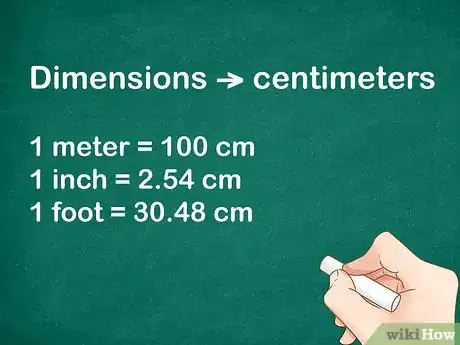










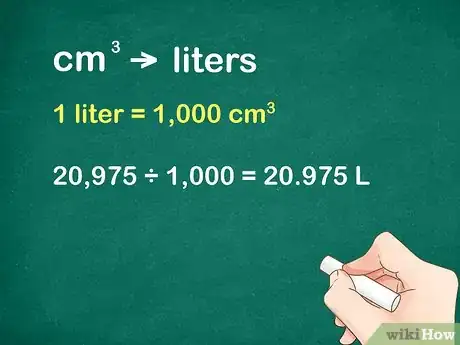




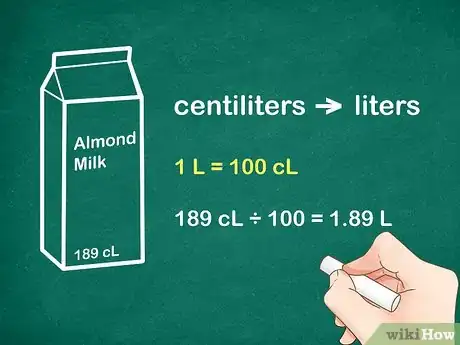



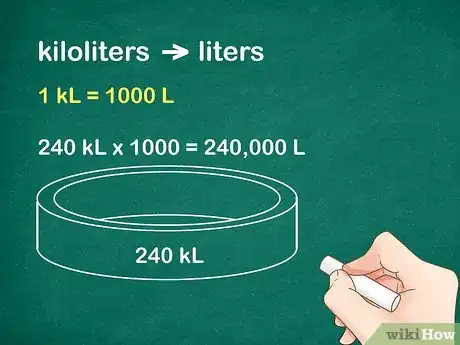

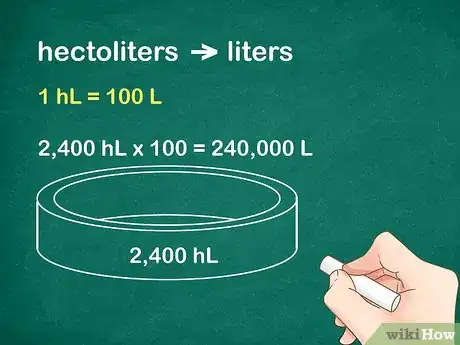

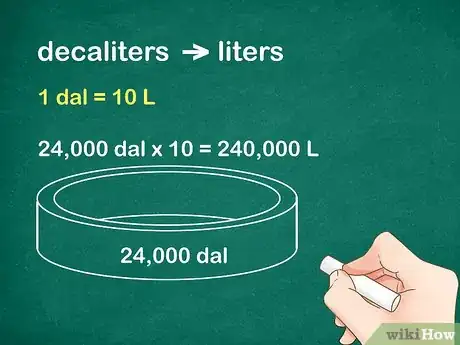



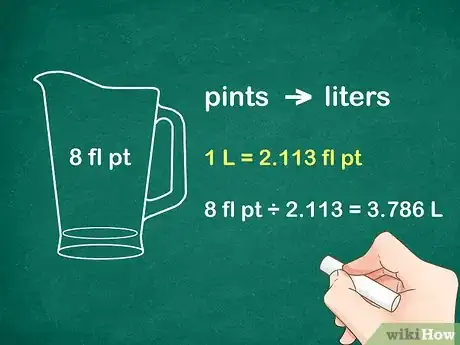






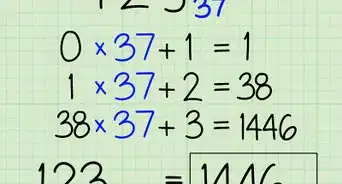

-to-Grams-(g)-Step-8-Version-5.webp)
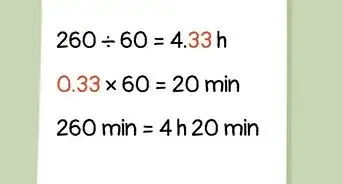
-to-Fahrenheit-(°F)-Step-6-Version-2.webp)
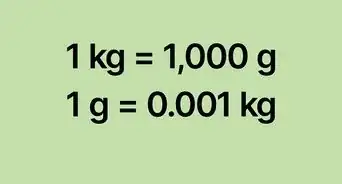
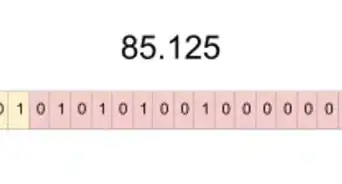
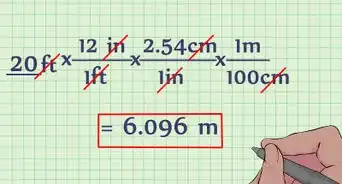

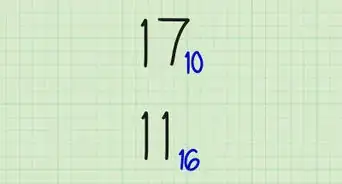
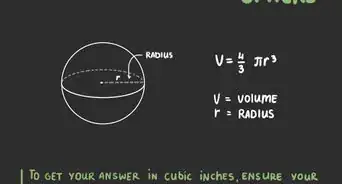

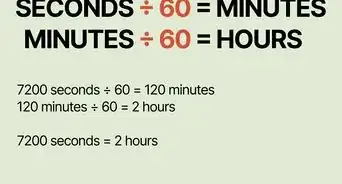








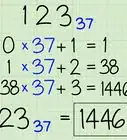
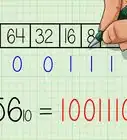
-to-Grams-(g)-Step-8-Version-5.webp)



































